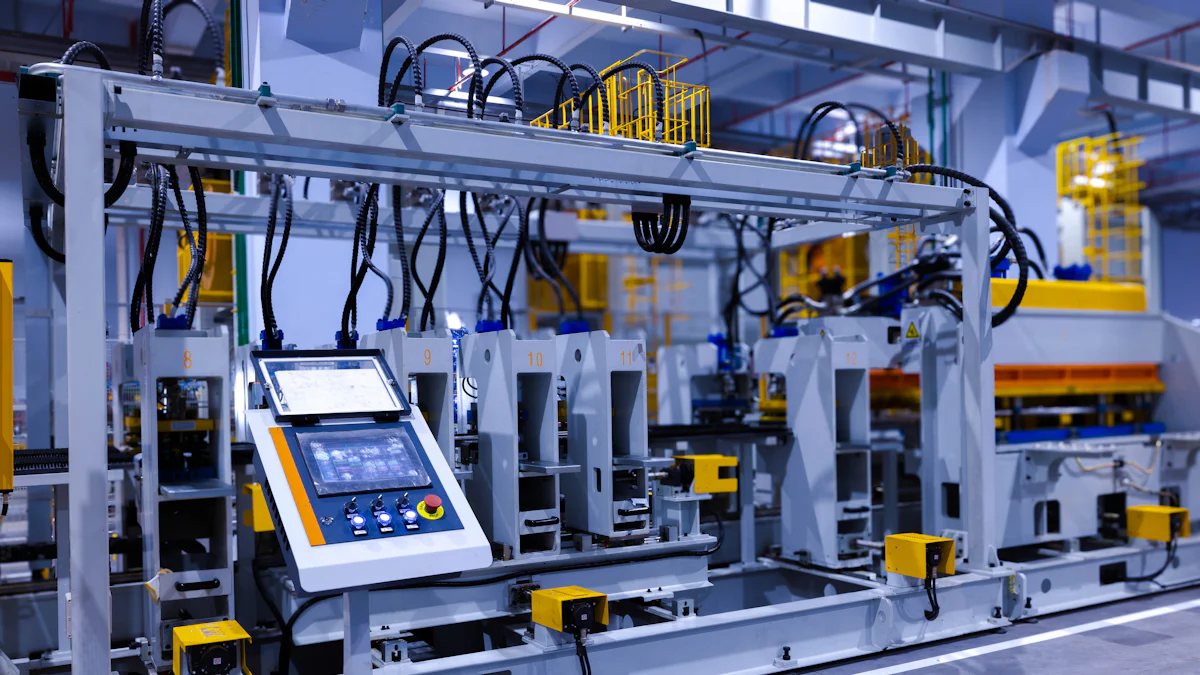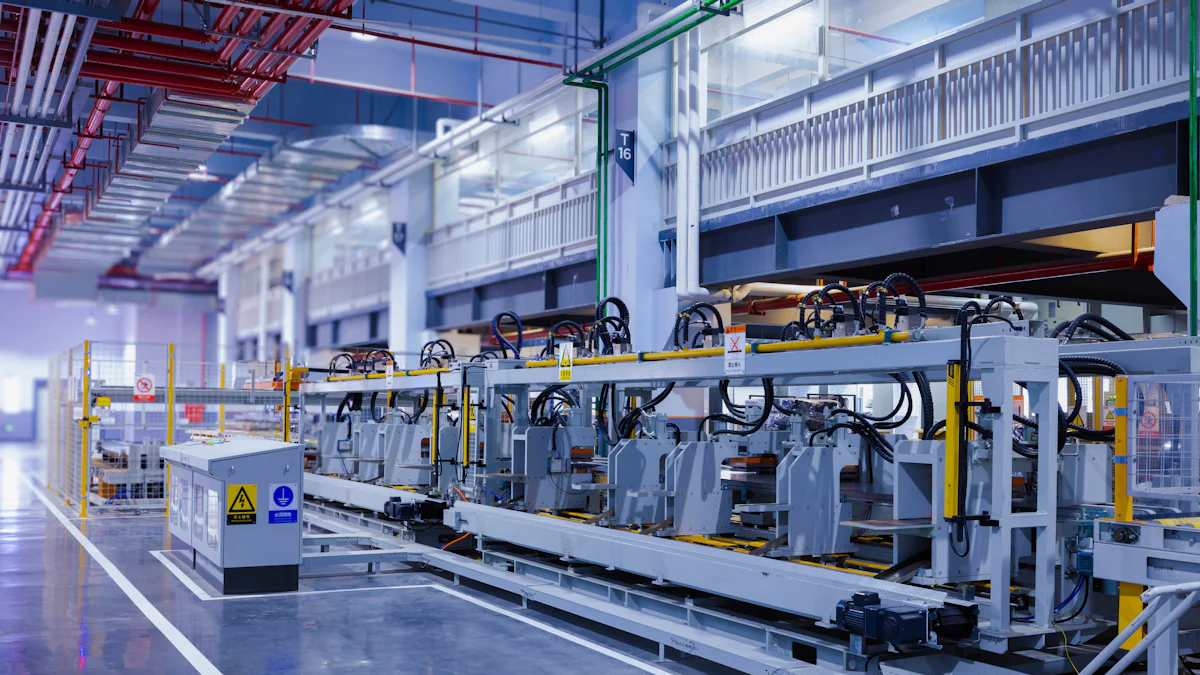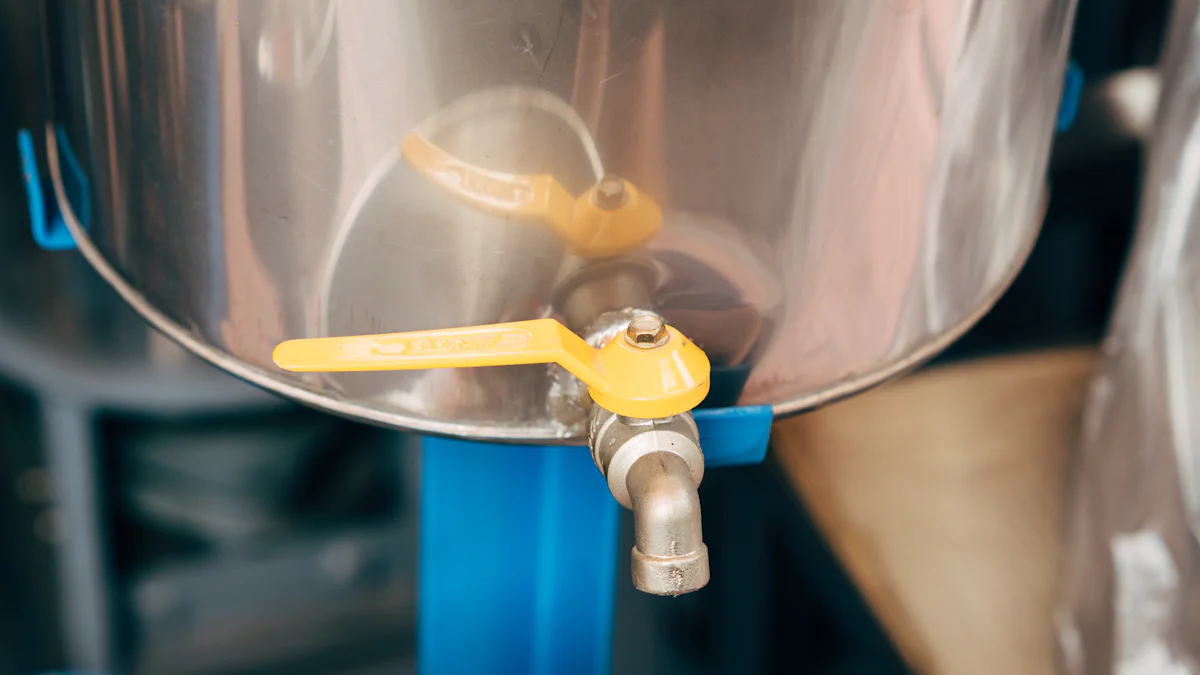What is a Dispenser and How Does It Work in Manufacturing

A dispenser in manufacturing is a device designed to release specific amounts of materials, such as liquids, adhesives, or powders, with precision. In this context, it plays a critical role by ensuring consistent application of materials during production. You’ll find dispensers in processes where accuracy and repeatability are essential, such as assembling electronics or packaging goods.
Precision dispensing minimizes waste and enhances efficiency by automating material application. This reduces manual errors and improves product quality. With the global industrial dispenser market projected to grow from $9.93 billion in 2023 to $16.87 billion by 2032, it’s clear that dispensers in manufacturing are transforming modern production by making processes faster, more reliable, and cost-effective.
What is a Dispenser in Manufacturing?
Definition and Purpose of a Dispenser
A dispenser in manufacturing is a tool or device that releases specific amounts of materials like adhesives, liquids, or powders. Its primary purpose is to ensure accurate and consistent application during production. You can find dispensers in industries where precision is critical, such as electronics, automotive, and pharmaceuticals. By automating material application, dispensers help maintain uniformity and reduce errors, which is essential for high-quality manufacturing.
Key Features of a Dispenser
Dispensers come with features that make them indispensable in manufacturing. These include:
Precision Control: They release exact amounts of material, ensuring consistency.
Adjustable Settings: You can customize flow rates and volumes to suit different applications.
Compatibility: Many dispensers handle a variety of materials, from thick adhesives to fine powders.
Automation Capabilities: Advanced dispensers integrate with automated systems for seamless operation.
These features make dispensers versatile tools that adapt to the demands of modern production lines.
Why Dispensers Are Essential in Manufacturing Processes
Dispensers play a vital role in maintaining high-quality standards in manufacturing. For example, in adhesive application, they ensure precise dosing, which prevents product defects and guarantees proper bonding. This precision is especially important in high-volume production, where even small errors can lead to significant losses.
You also benefit from reduced material waste when using dispensers. Automated dosing applies only the necessary amount, which lowers costs and supports environmental sustainability. Additionally, the growing trend toward automation in manufacturing has increased the demand for dispensers. Industries now rely on these tools to enhance speed, improve consistency, and reduce operational costs.
By incorporating dispensers into your production processes, you can achieve better efficiency, higher product quality, and long-term cost savings.
How Do Dispensers Work?
Basic Working Principles of a Dispenser
Dispensers operate by controlling the release of materials with precision. The process begins with creating a batch of materials that need dispensing. You then define detailed reservations for the materials, ensuring they meet the required specifications. Operators follow instructions to weigh the materials accurately before dispensing them. Advanced systems, such as Oracle Manufacturing Execution System (MES), manage this process by tracking materials from inventory to production. These systems also handle labeling and containerization, ensuring every step is monitored for accuracy.
Dispensing must comply with strict guidelines, such as FDA regulations (Title 21 Part 211.101). This ensures safety, especially when working with hazardous substances like volatile organic compounds (VOCs). The integration of technology enhances control over material delivery, making the process both safe and efficient.
Steps in the Dispensing Process
The dispensing process involves several key steps:
Reserve the required materials for dispensing.
Match the paperwork to the chemicals or materials being dispensed.
Weigh the materials using calibrated scales.
Dispense the materials according to defined instructions.
Obtain electronic signatures to verify the process.
Print labels for the dispensed materials.
These steps ensure consistency and accuracy in manufacturing. Room clearance and clean-up are also essential, especially when handling chemicals. Operators must clear the workspace before introducing new materials and clean any residual dust after weighing.
Factors That Influence Dispensing Accuracy
Several factors affect the accuracy of dispensing in manufacturing:
Method of dispensing: The repeatability of each shot is crucial, especially in industries like life sciences.
Integrity of dispensing components: High-quality components, such as syringe barrels and dispense tips, ensure precise material delivery.
Process control parameters: Adjusting settings like time and pressure improves control and ensures accurate placement of materials.
By focusing on these factors, you can achieve precise and reliable results in your manufacturing processes. Automatic pallet dispensers, for example, enhance accuracy by automating material handling, reducing errors, and improving efficiency.
Types of Dispensers in Manufacturing

Manual Dispensers
Manual dispensers are simple tools that require physical interaction to release materials. These dispensers are cost-effective and easy to maintain, making them a practical choice for small-scale operations. You can place them anywhere without worrying about power requirements. For example, manual fluid dispensers are commonly used for basic applications where precision and repeatability are not critical.
However, manual dispensers have limitations. They lack portion control, which can lead to inconsistent material application. Additionally, they require frequent cleaning and may increase the risk of contamination in sensitive environments. Despite these drawbacks, their affordability and flexibility make them a popular choice in many industries.
Limitations of Manual Dispensers | |
|---|---|
Cost-effective | Greater potential for germ spread |
No power requirements | Uncontrolled product dispensing |
Easy maintenance | Requires frequent cleaning |
Flexible placement |
Semi-Automatic Dispensers
Semi-automatic dispensers bridge the gap between manual and fully automatic systems. These dispensers automate parts of the process while still requiring some operator involvement. For instance, semi-automatic label dispensers allow you to position products or initiate the dispensing process with a button. This setup improves efficiency compared to manual dispensers by reducing the time and effort needed for repetitive tasks.
You’ll find semi-automatic dispensers particularly useful in applications where moderate precision and speed are required. They are ideal for businesses looking to enhance productivity without fully transitioning to automated systems. By combining automation with manual control, these dispensers offer a balance of efficiency and flexibility.
Fully Automatic Dispensers
Fully automatic dispensers take efficiency to the next level by eliminating the need for manual intervention. These dispensers use advanced features like sensors to control the dispensing process. For example, automatic label dispensers apply labels to products as they move through a production line. This makes them highly effective in high-volume environments such as bottling plants and packaging facilities.
You can rely on fully automatic dispensers for consistent and precise material application. Their ability to handle large-scale operations with minimal errors makes them indispensable in industries where speed and accuracy are critical. These dispensers not only improve productivity but also reduce material waste, ensuring cost savings over time.
Specialized Dispensers for Specific Materials
Specialized dispensers are designed to handle specific materials, ensuring optimal performance in manufacturing. These dispensers cater to unique material properties, such as viscosity, particle size, or chemical composition. For example, adhesive dispensers apply glue or sealants with precision, while powder dispensers handle fine particles without clumping. You can also find liquid dispensers that manage fluids of varying thickness, from water-like substances to thick gels.
These dispensers often include advanced features to meet the demands of specific industries. For instance, in electronics manufacturing, solder paste dispensers ensure accurate placement of conductive materials on circuit boards. In the food industry, dispensers for sauces or toppings maintain hygiene and consistency. By using specialized dispensers, you can achieve higher accuracy, reduce waste, and improve product quality.
Pallet Dispensers and Their Role
Pallet dispensers play a crucial role in streamlining material handling in manufacturing. These machines automate the loading, storing, and dispensing of pallets, which significantly boosts efficiency and safety. Unlike other pallet handling equipment, pallet dispensers can operate manually or automatically. Automatic models fully automate both loading and dispensing processes, making them ideal for high-volume operations.
When you use a pallet dispenser, you eliminate the need for manual labor in stacking or unstacking pallets. This reduces the risk of workplace injuries and ensures a smoother workflow. Pallet dispensers also save time by quickly dispensing pallets for use in production or shipping. If your operation involves dispensing pallets frequently, investing in a pallet dispenser can enhance productivity and reduce operational costs.
By incorporating these dispensers into your manufacturing process, you can optimize material handling and focus on core production tasks.
Benefits of Using Dispensers in Manufacturing
Improved Precision and Accuracy
Dispensers allow you to achieve exceptional precision in material application. Whether you work with adhesives, liquids, or powders, these tools ensure consistent results. Advanced dispensers use regulators, timers, and software to control the flow of materials. For example, the EFD Ultimus V dispenser enhances accuracy by using precise timing mechanisms. This level of control minimizes errors, ensuring that every product meets high-quality standards.
In industries like electronics or pharmaceuticals, even minor inaccuracies can lead to defects. Dispensers eliminate this risk by delivering materials exactly where they are needed. By investing in automated dispensing technologies, you can maintain consistent quality across your production line. This not only improves your products but also strengthens your reputation for reliability.
Enhanced Efficiency and Productivity
Using dispensers significantly boosts your operational efficiency. Automated dispensers streamline repetitive tasks, allowing your team to focus on more complex operations. For instance, fully automatic dispensers handle high-volume production with minimal supervision. This reduces downtime and increases throughput, helping you meet tight deadlines.
The integration of Industry 4.0 concepts, such as IoT connectivity, further enhances productivity. Smart dispensers monitor and optimize processes in real time, ensuring smooth operations. By adopting these technologies, you can improve your production capabilities while reducing labor costs. This makes dispensers an essential tool for achieving long-term growth and success.
Reduction in Material Waste
Dispensers play a crucial role in minimizing material waste. Precision dispensing ensures that you use only the required amount of material, reducing excess usage. Improvements in dispensing technology have led to significant waste reductions, especially in adhesive applications.
“Using the proper piston will wipe the inside walls clean, greatly reducing the amount of waste,” adds Muccino. “[Our] SmoothFlow pistons are manufactured with precise tolerances to the inside walls of the syringe, ensuring that 99 percent of the fluid in the syringe reservoir will be dispensed.”
Pump dispensers also contribute to sustainability. Their design ensures full utilization of materials, leaving minimal residue. Many dispensers are made from recyclable materials, aligning with environmentally conscious practices. By reducing waste, you not only save costs but also support eco-friendly manufacturing. This aligns with the goals of modern brands and consumers who prioritize sustainability.
Cost Savings Over Time
Investing in dispensers, especially a pallet dispenser, leads to significant cost savings over time. Automation reduces your reliance on manual labor, which lowers labor costs. By eliminating repetitive tasks, you can reallocate your workforce to more complex and value-driven activities. This shift not only saves money but also enhances overall productivity.
Maintenance costs also decrease when you use a pallet dispenser. These machines are designed for durability and require minimal upkeep. Unlike manual handling, which often results in wear and tear on equipment, automated systems streamline operations with fewer interruptions. Over time, this translates into reduced repair expenses and extended equipment lifespan.
Material waste reduction is another way dispensers save money. Precision dispensing ensures you use only the required amount of material, minimizing excess usage. For example, in adhesive applications, dispensers apply the exact quantity needed, preventing overuse. This efficiency not only cuts costs but also supports sustainable practices, which can enhance your brand's reputation.
Space optimization further contributes to cost savings. A pallet dispenser helps you maximize warehouse space by automating pallet stacking and unstacking. Efficient space utilization reduces the need for costly warehouse expansions. By investing in automation, you can achieve long-term financial benefits while improving operational efficiency.
Why You Should Invest in a Pallet Dispenser
Understanding why you should invest in a pallet dispenser begins with recognizing its transformative impact on your operations. This machine automates repetitive tasks, such as stacking and unstacking pallets, which boosts efficiency. By reducing manual handling, you address labor shortages and minimize workplace injuries.
A pallet dispenser also drives cost savings. Automation lowers labor costs and reduces the need for additional staff. Maintenance costs remain low due to the machine's robust design. Additionally, efficient pallet handling prevents damage to materials, saving you money on replacements.
Safety is another critical benefit. Manual pallet handling often leads to injuries, which can disrupt operations and increase healthcare costs. A pallet dispenser eliminates these risks, creating a safer work environment.
Space optimization is a key advantage. By automating pallet management, you maximize warehouse space. This efficiency reduces the need for expansion, saving you significant costs.
Benefit | Description |
|---|---|
Efficiency | Increases operational efficiency by automating repetitive tasks. |
Safety | Enhances safety by reducing manual handling and associated injuries. |
Cost Savings | Reduces labor costs through automation and lowers maintenance costs. |
Space Optimization | Maximizes warehouse space, potentially reducing the need for expansion. |
Investing in a pallet dispenser ensures long-term benefits for your manufacturing operations. It enhances efficiency, reduces costs, and creates a safer workplace. These advantages make it clear why you should invest in a pallet dispenser to optimize your processes.
Industries and Applications of Dispensers

Electronics Manufacturing
Dispensers play a vital role in electronics manufacturing by ensuring precise material application. You can use them for tasks like chip encapsulation, display fixation, and camera module assembly. These applications are critical in industries such as semiconductor IC packaging and smartphone production. For example, precision dispensing in Printed Circuit Board Assembly (PCBA) ensures product quality and reliability.
Small components like microchips and sensors require exact adhesive application. Dispensers help you achieve this by delivering consistent and minimal amounts of adhesive. This precision reduces errors and enhances the durability of electronic devices. Adhesive dosing dispensers are in high demand because they ensure consistent bonding, which is essential for maintaining product performance.
By incorporating dispensers into your electronics production line, you can improve efficiency and meet the high standards required in this industry.
Automotive Industry
In the automotive industry, dispensers improve production processes by ensuring precision and consistency. You can use them to apply adhesives and sealants, which protect components from environmental damage. Automated systems reduce labor time and costs by providing consistent output. This minimizes rejects and rework, saving you both time and money.
Controlled dispensing increases production rates while maintaining product quality. For example, dispensers ensure that only the necessary amount of adhesive is applied, reducing material waste. This cost-efficiency is crucial in large-scale automotive manufacturing. Automated dosing systems also prevent overuse or underuse of materials, ensuring optimal performance of vehicle components.
By using dispensers, you can streamline your production processes, reduce waste, and enhance the quality of your automotive products.
Food and Beverage Production
In food and beverage production, dispensers ensure hygiene and consistency. You can use them to apply sauces, toppings, or other ingredients with precision. This is especially important in high-volume operations where uniformity is key. For example, dispensers help you maintain consistent portion sizes, which improves product quality and customer satisfaction.
Customizable features allow you to adjust dispensing parameters for specific recipes or production needs. Material-specific configurations ensure that dispensers handle different food textures, from liquids to viscous sauces, without compromising performance. Automation further enhances efficiency by reducing manual labor and speeding up production.
By integrating dispensers into your food and beverage operations, you can achieve higher productivity, maintain quality standards, and meet regulatory requirements.
Pharmaceutical and Medical Applications
Dispensers play a critical role in pharmaceutical and medical applications by ensuring precision and safety. You can rely on these systems to streamline medication management through three essential steps: prescription entry, patient labeling, and medication selection. Automated dispensers verify prescriptions against electronic health records, ensuring that the correct medication is dispensed. This process prevents errors and safeguards patient health by matching medications with doctor’s orders. Real-time tracking and reporting further enhance medication adherence and support coordinated care within healthcare networks.
In life sciences, fluid dispensing systems are designed for exceptional accuracy and repeatability. These systems often include programmable sequencing and automated optical inspection (AOI) to ensure precise fluid deposit volume and placement. For example, digital dispense logs record parameters, which helps you comply with stringent regulatory requirements. Whether you are working with vaccines, diagnostic reagents, or other medical products, dispensers ensure consistent results while maintaining safety standards.
By integrating dispensers into your pharmaceutical or medical operations, you can improve efficiency, reduce errors, and meet regulatory demands. These systems not only enhance patient safety but also optimize your workflow, making them indispensable in healthcare settings.
Aerospace and Other Relevant Industries
In the aerospace industry, dispensers are essential for maintaining structural integrity and ensuring precision. You can use them for a variety of applications, such as bonding stringers to wing skins or sealing doors, windows, and fuselage components. Dispensers also play a role in sealing the edges of honeycomb panels and carbon-fiber composite brackets. By filling cut edges of honeycomb panels and molded composites, dispensers help maintain the strength and durability of these materials.
Other common uses include dispensing sealant onto overlapping sheet metal pieces (face seals) and between vertical and horizontal parts (filet seals). You can also use dispensers to fill standardized cartridges with premixed two-component adhesives and sealants. These applications ensure that aerospace components meet the highest standards of quality and safety.
Dispensers reduce manual labor and improve consistency in aerospace manufacturing. By automating these processes, you can enhance efficiency and minimize errors. This precision not only improves the performance of aircraft but also reduces material waste, making dispensers a valuable tool in this industry.
Tip: While dispensers are not directly involved in reducing pallet damage, their role in automating material handling indirectly supports safer and more efficient workflows.
See Also
Understanding QFD, FMEA, And DOE's Impact On Quality
Exploring Functional Testing In CNC And Die Casting Methods
Seven Essential Steps To Collaborate With A Diecast Factory
Anodizing Explained: Its Application In Die Casting Products
Understanding MOQ And Its Effects On RFQs
About Hunan Puka
Established in 2016 and based in Hunan, China, with a liaison point in Berlin, we are a Tier 2 supplier for the automobile industry. We specialize in the production of customized aluminum die-casting parts designed for machines with a closing force ranging from 280 to 800 tons, with subsequent manufacturing process CNC machining and surface treatment. Our commitment to quality is reflected in our accredited quality management system, certified by ISO9001:2015 and IATF16949:2016 standards.


